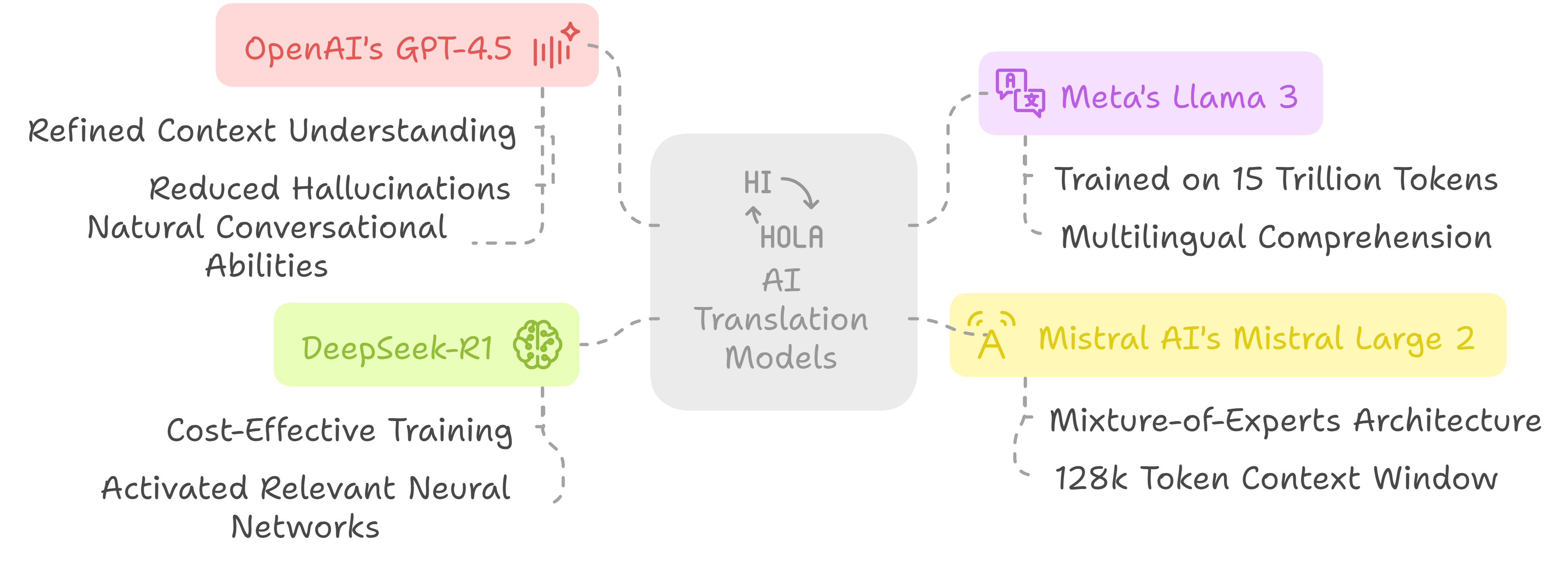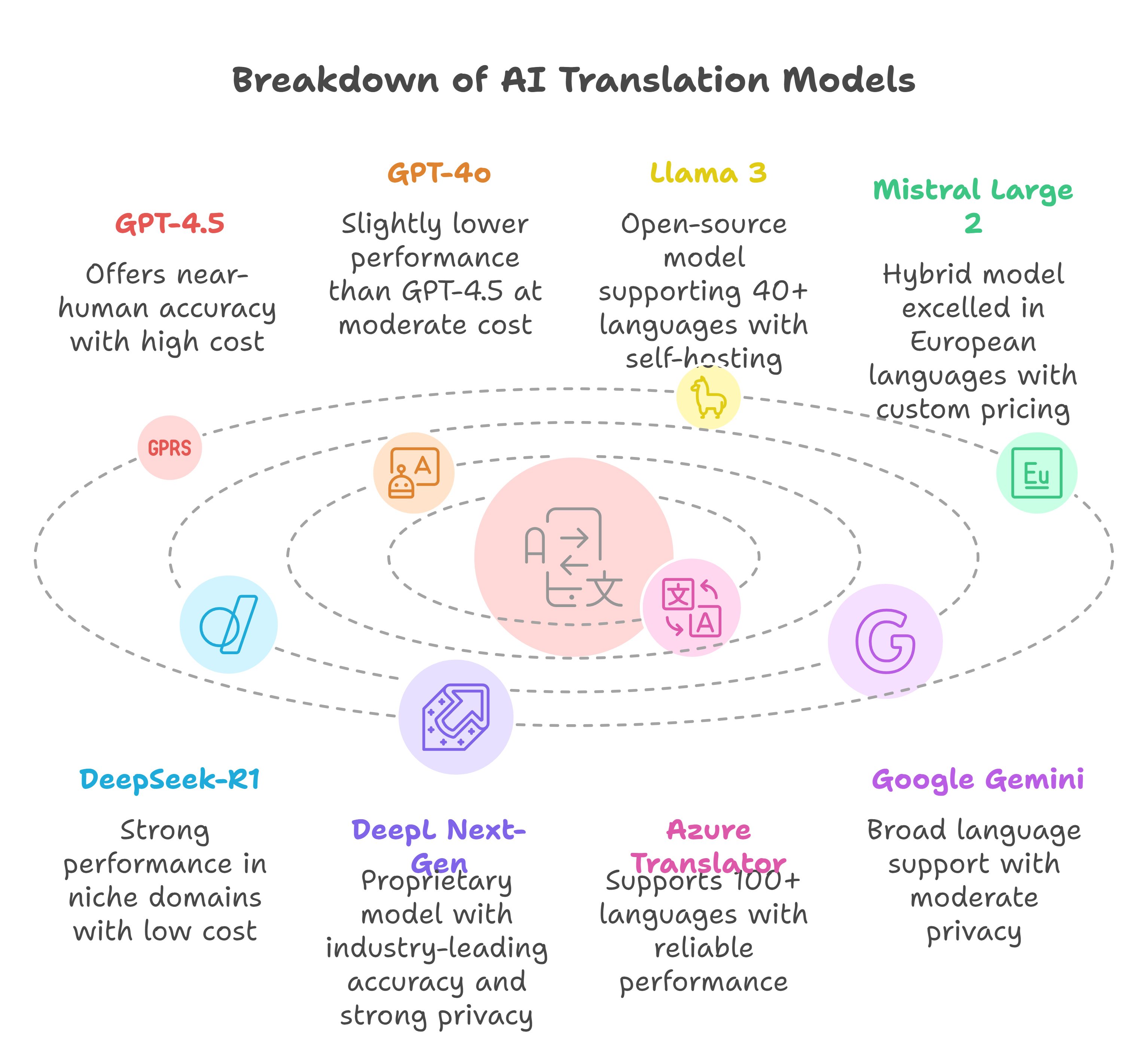The year 2025 marks an extraordinary advancement in AI language models, fundamentally reshaping the landscape of machine translation. Today’s cutting-edge models deliver translations of unprecedented accuracy, multilingual capability, and contextual awareness.
Key Advancements in 2025 AI Translation Models

Enhanced Capabilities of Leading Models
- OpenAI’s GPT-4.5 is a powerful successor to GPT-4, boasting refined context understanding, reduced hallucinations, and more natural conversational abilities. It excels in nuanced and complex translations, often nearing human accuracy.
- Meta’s Llama 3 is an open-source model trained on a massive 15 trillion tokens, specifically designed to improve multilingual comprehension across 40+ languages. It has proven competitive with leading proprietary models, making it an ideal foundation for high-quality, privacy-sensitive translation projects.
- Mistral AI’s Mistral Large 2 employs a mixture-of-experts (MoE) architecture with an extraordinary 128k token context window, facilitating highly accurate translations of lengthy documents and complex texts.
- DeepSeek-R1, developed by China’s DeepSeek, achieves remarkable translation quality and efficiency by activating only relevant neural networks.
Multilingual and Culturally Aware Translations
Models like GPT-4.5 and Meta’s Llama 3 are now thoroughly multilingual, supporting languages as diverse as Arabic, Swahili, and Yoruba. GPT-4.5 consistently outperforms GPT-4o across multiple languages, improving translation accuracy significantly.
Multi-Modality and Long Contexts
Newer models like GPT-4o and Mistral Large 2 accept images, audio, and extensive textual inputs, supporting use cases such as translating visual content or video subtitles seamlessly. Meta’s SeamlessM4T even unifies text and speech translation into a single model covering nearly 100 languages.
Comparison of AI Translation Models (2025)

| Model | Type & Access | Languages | Performance | Privacy | Cost |
|---|---|---|---|---|---|
| GPT-4.5 | Proprietary, API-based | ~15 major languages | Near-human accuracy, nuanced context handling | Cloud only; enterprise privacy options | Very high (~$150 per 1M tokens) |
| GPT-4o | Proprietary, API-based | ~15+ languages | Slightly below GPT-4.5 but excellent for general tasks | Cloud-only, standard privacy controls | Moderate (~$10 per 1M tokens) |
| Llama 3 (Meta) | Open-source | 40+ languages | High quality, competitive with GPT-4 | Excellent (self-hosting possible) | Hardware costs, no API fee |
| Mistral Large 2 | Proprietary/Open hybrid | Dozens (major EU languages) | Excellent for European languages, large contexts | EU compliance, data stays in EU | Custom pricing, likely competitive |
| DeepSeek-R1 | Open-source | Several (Chinese, English, Spanish, Serbian, etc.) | Strong, variable across niche domains | High (self-hosting available) | Low cost, resource-efficient |
| DeepL Next-Gen | Proprietary API | 31 languages (EU, Asian) | Industry-leading, minimal editing required | Strong privacy (Germany-based) | Moderate (~$25 per 1M chars) |
| Azure Translator | Proprietary API | 100+ languages | Reliable, good for bulk & real-time | Strong enterprise privacy | Low (~$10 per 1M chars) |
| Google Gemini | Proprietary API | 130+ languages | Broad support, very strong general translation | Moderate (good privacy on paid API) | Moderate (~$20 per 1M chars) |
| Meta NLLB-200 | Open-source | 200 languages, especially rare languages | Best for low-resource languages | Excellent (self-hosted) | Hardware costs, no API fee |
Translation Performance Metrics and Benchmarks
Metrics like BLEU and TER are still standard benchmarks, yet increasingly fall short in evaluating modern AI models, as these often produce translations that paraphrase rather than exactly match references. Advanced metrics like COMET and BERTScore better align with human judgment, reflecting the semantic accuracy and naturalness of the output.
GPT-4, for example, reached near-human parity in translation, making roughly the same number of errors as professional translators. DeepL’s Next-Gen model, meanwhile, has proven superior on practical translation tasks, requiring significantly fewer corrections than Google or GPT-4.
Privacy and Cost Considerations
Selecting a translation solution involves balancing quality, privacy, and cost:
- OpenAI’s GPT-4.5 offers premium quality but is cloud-only and costly.
- Meta’s Llama 3 provides the highest privacy as an open-source model but requires considerable infrastructure investment.
- Mistral AI offers a hybrid solution with EU data privacy compliance, potentially offering a cost-effective and high-quality alternative.
- DeepSeek-R1 is ideal for budget-conscious users needing secure, self-hosted translation.
- Azure and Google Translate excel in affordability and coverage, best suited for bulk or real-time translations at scale.
Ideal Use Cases and Recommendations
- High-Quality Critical Content (Legal, Medical): GPT-4.5, DeepL Next-Gen.
- Bulk and Real-Time Translations: Azure Translator or Google Translate API for scalability and affordability.
- Privacy-Sensitive Applications: Llama 3 and DeepSeek-R1 for local hosting and data control.
- Rare and Low-Resource Languages: Meta NLLB-200 for maximal linguistic inclusivity.
- AI-Assisted Human Translation: GPT-4o and DeepL as powerful productivity tools reducing post-editing workload.
Conclusion
The AI-driven translation landscape of 2025 has reached unprecedented levels of accuracy, flexibility, and customization. Organizations and individuals now have a wealth of sophisticated options that offer unmatched quality, specialized capabilities, and privacy options to precisely fit their translation needs.
